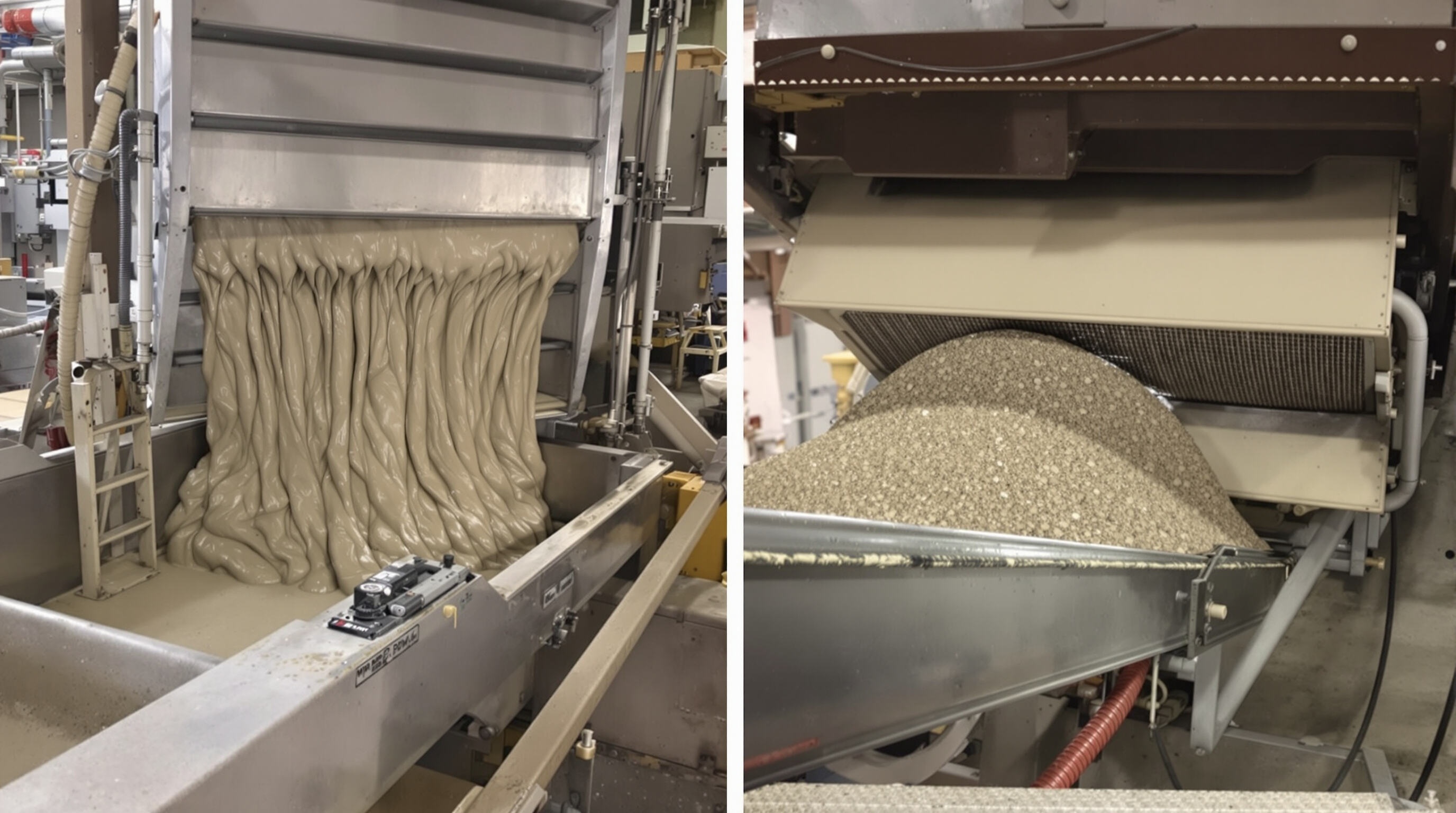Негизги иштөө принциптери: Шайкүлөш экраны машинасы титирөөчү экран менен салыштырмалуу
Чачыранма экрандык машиналар так бөлүш үчүн теребөөчү кыймылдан кантип пайдаланат
Чечмелүү экрандык машиналар бөлүүчүлөрдү чын эле жакшы бөлүп турат, анткени алар кол менен чакан заттарды сүзгүчтөй иштетүүчү үлгүдөгү айлануу түрүн колдонушат, бирок бул көп чоң көлөмдө иштейт. Алардын жөнгө салынган экрандардан айырмасы материалдардын бетинен өтүүдө спираль түрдө кыймылдоосунда. Бөлүүчүлөр горизонталдуу айланып турган сапарда алга көчүп турат. Бул артка кетүү иш-аракети кичине бөлүүчүлөрдүн орундарын өзгөртүп турган жана тордун чыгышына түшүү мүмкүнчүлүгүн көбөйтөт. Өткөн жылы жарыяланган илимий изилдөө бул эки экран системасын эски вибрациялык системалар менен салыштырганда чечмелүү экрандар тосууларды 40% кыскартып тургандыгын көрсөткөн. Бул машиналардын эксцентрик тегеректер менен иштетүү учурунда сынгыч же бириккен материалдарга жумшак иштетүүгө мүмкүнчүлүк берет, демек, көптөгөн өнөр жай тутумдарында иштетүү жүрүшүндө зыян келтирүү азаят.
Вибрациялык экрандар: Сызыктуу жана Айланма вибрация механизмдерин түшүнүү
Бүгүнкү күндө вибрациялык решеткалар негизинен эки түрдө иштейт: сызыктуу кыймыл же ошол эксцентриктик тартылардын бири-бирине каршы айлануусунан пайда болгон айлана кыймыл. Сызыктуу түрү чоң бөлүкчөлөрдүн чоң көлөмүн тездек алып жүрүү үчүн туурасында артка-алга титирөт. Айлана түрү ичиндеги муундагы моторлордун айлануусу аркылуу эллипстин ичинде заттарды айландырат. Бул эркин ийленип турган күчтөрдүн натыйжасында чөкмө бетинен өтүп жаткан ар түрдүү өлчөмдөгү материалдарды сүзүп чыгат. Көбүнчө өнөр жай тажрыйбалары бул решеткаларды 600 менен 3600 айлануу аралыгында ылдый иштетет. Бул тездик бөлүкчөлөрдү тездек жогору-төмөн титирөтүп, кыска мөөнөттө көп материал өтүшүн камсыз кылат. Бирок, нюанстар бар: жайгак порошоктор бири-бирине жабышып, решетканын тескейин бетер же кээ бир нәзик материалдар тымызын вибрациядан зыян көрөт.
Талаштыруу түрлөрүн салыштыруу: Айлана талаштыруу менен Стандарт талаштыруу түрлөрү
| Кыймыл өзгөчөлүгү | Чакырма экран | Стандарт түрдөгү талаштыргыч экран |
|---|---|---|
| Чыгуу диапазону | 100–400 RPM | 600–3600 RPM |
| Бөлүкчө траекториясы | Спиралдык айлануу | Тикке карай секирүү |
| Материалды узак кармоо | 2–3 эсе узак | Кыска мөөнөттүү байланыш |
| Энергия катуу | 30% азырсаак | Жогорку интенсивдүүлүк талап кылынат |
Тербелмелүү решеткалардын орбиталдык траекториясы баскычтуу түрдө чөккүн шарттарды камсыз кылат, ал эми тербелмелүү решеткалар активдүү жылышты өнүктүрөт. Аялдаткан тербелмелүү кыймыл бөлүкчөлөрдүн сындырылышын минималдаштырат—бул дарылар же тамак-аш үлгүлөрү үчүн маанилүү.
Аткаруу боюнча талаш: Негизги Тербелмелүү Кыймыл Фракциялар Үчүн Лучше?
100 микрондон кичинекей бөлтөрлөр менен иштөөдө качыратма экран технологиясы чыныгы жакшы иштейт. Бул экрандар бөлүкчөлөргө бетинде бир нече жолу туура ойдошуп түшүүгө убакыт берет. Бул жыйнактын азын жыйнагын көбөйтөт. Particle Science Journal журналындагы изилдөөлөр бул жөндөмдүлүктүн 28% чамалуу арттырышын көрсөткөн. Бирок, жогорку жыштыктагы тербелмелүү экрандар башка тарых айтат. Ал кичине бөлтөрлөрдү айырып албай эле чачып жиберет. Качыратма экрандардын айырмасы жумшак кыймылы нымдуу материалдар менен иштөөдө тор жолу ачык калуусу менен тийиштүү. Бул аларды так айырмалоого жараша, башка варианттар сыяктуу чоң көлөмдөгү чоң материалдарды тездик менен иштебейт дегенди билдирет.
Экрандоо эффективдүүлүгү жана Бөлтөр өлчөмүн айырмалоо мүмкүнчүлүгү
Азын материалдарды айырмалоодогу эффективдүүлүк метрикалары: Качыратма менен Тербелмелүү экрандар
Экран кандай иштээрин экран аркылуу өткөн жана калган материалдарды салыштыруу менен билүүгө болот. Тала качыруучу экрандарды вибрациялык экрандар менен салыштырганда алардын иштөө мүмкүнчүлүгүнүн айырмасы байкалат. Тала качыруучу экрандар 1 мм ден кичине фракцияларды жакшыраак өткөрөт, анткени алар бурулуп-чечкилип иштейт. Бул кыймыл кичине бөлүкчөлөрдү чоң бөлүкчөлөргө жабышып калуудан сактайт. Вибрациялык экрандар болсо, формасы түзгүсүз бөлүкчөлөр же нам жабышкан материалдар менен иштөөдө жакшы натыйжа бербейт. Бул учурда алардын иштөө сапаты 12-15% кемиши мүмкүн. Өткөн жылы «Advanced Powder Technology» журналында жарыяланган илимий изилдөөлөр бул жагылган фактты да тастыктайт. Бул жүгүртүүчү кыймыл бөлүкчөлөрдүн тыгыз ортодо өз ара тарта алышын жакшыртат. Натыйжада майдаланган материалдарды айыруу процесстеринде калдык азайып, иштөө ылдамдыгы артат.
Бөлүкчөлөрдүн формасы, тыгыздыгы жана таралышы чыгыш сапатына кандай таасир этет
Бөлүкчөлөрдүн касиеттери түрүүлөөнүн тактагына түздөн таасир этет:
- Түзүлүшү дүүлүк эмес (мисалы, пластинкалар же талкалар) теребелеген түрүүлөрдө 30% көбүрөөк түткүлөөнүн жаралтуу кордун көбөйтөт
- Жогорку тыгыздыктагы бөлүкчөлөр стратификация тез болот, бирок терс белгилүү теребүүлөрдө түрүүнүн зыян келтириди
-
Кенен өлчөмдөрдүн таралышы ирет бөлүкчөлөрдүн чоң катмарлардын астында калып, чыгымды төмөндөтүүгө алып келет
Нымдуулук бул маселелерди күчөтүп, жабыштыруучу күчтөрдү көбөйтөт. Айлана түрүү машиналары бул жагдайга жумшак кыймыл аркылуу каршы турат, бөркүт же дарылар сыяктуу бириккен материалдар үчүн 92–95% эффективдүүлүктү сактап турат.
Тербелүү жилдамдыгынын парадоксу: Неге жогорку тербелүү ар дайым жакшы эмес?
Чоң вибрация ишти чын эле аз эффективдүү кылат. Амплитуда 8 мм ашып кеткенде, бөлүкчөлөр экранда жетиштүү убакыт кармалбай, бардык жерде секире баштайт. Бул экран менен алардын контакт убактысын 40% ке азайтат жана процессте көбүрөөк энергиясын чардалайт. Жогорку жыштыктагы вибрация экрандарды тез изилетет жана минералдар же бидай сыяктуу нәзик нерселерди бузуп салууга болот. 2017-жылы Fuel тарабынан жасалган изилдөөлөрдө экрандар 800-1200 RPM орточо ылдамдыкта иштаганда эң жакшы иштээрин көрсөткөн. Эгер алар андан ары ылдамыраак иштесе, өндүрүмдүн чыгымы 7-10 пайызга түшөт. Тербелме экрандар 500-700 RPM ортосунда, бөлүкчөлөрдү сактап, жакшы айыру натыйжаларын алуу үчүн бир аз ылдамыраак иштөөгө түзүлгөн.
Вибрациялык режимдин толук экрандоо тактыгы менен чыгымга таасири
Титирөө үлгүсү бөлүкчөлөрдүн агымын белгилейт: тербелүү кыймылы бирдей катмарланууну камсыз кылат, 15% га чейинки айырмачылыктар үчүн чыгымды кемитет жана чыгымды 15% арттырат.
Материалдын уюшарлыгы: Экран түрүн киргизүү сипаттары менен дал келтирүү

Клиент же нам жабдуулар менен иштөө: Тербелүү экраны машинасынын артыкчылыктары
Качели экраны машиналары ылгак заттар менен ылгакчылык менен жабдылган материалдар менен жакшы иштейт, анткени алардын алга-арка теги башкарылуучу кыймылы бар. Традициондык тербелмелүү экрандар заттардын топтолушуна алып келет, бирок бул качели экрандар овозду ишетүүчү материалдарды экран бетин тосуп койбой өзгөчө жумшак ажыратат. Бир нече өнөр жай тесттери 5 мм ден төмөнкү нымдуулугу 8% дан ашык материалдар менен иштөөдө калың тербелмелүү экрандар менен салыштырганда ылгак известняк бөлүкчөлөрүн ажыратууда натыйжалуулук 20% га жогору экенин көрсөткөн.
Агымдуулук жана Нымдуулук: Туура Сүзгүч Чечимин Тандаңыз
Материал агымынын сипаттамалары жабдыктын тандалышын аныктайт:
- Эркин агып чыгуучу гранулалар (≤3% шира): Жогорку жыштыктагы тербелмелүү решеткалар 95–98% ажыратуу тактагын камсыз кылат
- Жарым-жартылай бириккен тозуулар (4–7% шира): Айланма решеткалар 85–90% өткөрүмдүүлүктүн туруктуулугун сактайт
- Жогорку татаалдуу карыштар (≥8% шира): Айланма решетка машиналары багытталган чыгаруу күчтөрү аркылуу материалдын жабышын 40% кыскартат
Бөлүкчөлөрдүн биригиши менен тербелүү күчү ортосундагы мунонзак формадагы байланыш – ашыкча тербелүү ширадагы материалдарда капилляр күчтөрдү күчөйт, ал эми энергия жетишсиз болсо беттик керилүүнү бузууга мүмкүнчүлүк бербейт. Айланма решеткалар ширадагы материалдарды ажыратуу үчүн көбүнчө колдонулуучу оңдук диапазондо (2–5Гц) иштейт.
Күрөңдүү жана система оптимизациясы: торчонун чоңдугу жана решетканын долбоору
Өткөрүмдүүлүк жана узак мерзимдүүлүк үчүн оптималдуу торчо чоңдугун тандаңыз
Тордун чыгышын так аныктап алуу - бөлүп чыгуу сапаты менен материалдын өтүү мүмкүнчүлүгүнүн ортосундагы тепе-теңдикти табуу менен гана чектелет. Жарты миллиметрге чейинки бутактуу торлор кичине бөлүкчөлөрдү кармап алса да, жабышкан материалдар менен иштөөдө жыш кездешет, ал эми ылгак жагдайда чыгым 30% чейин камтылат. Экинчи тарабынан, беш миллиметрден жогорку чоюн торлор көп өлчөмдү материалдар үчүн жакшы иштейт, бирок заттарды так түрдө саралоого жөндөмсүз. Тордун чыгышы үчүн чыныгы маанилүү нерсе бөлүкчөлөр бир жерде топтолгондо чыныгы өлчөмү ондон үчөн пайызга чейин кемитилгени менен, анын чыгышында көрсөтүлгөндөй болбосо болот. Коррозияга туруктуу материалдар кабаттуу материалдарга каршы узакка созулса, полимер торлор органикалык заттар менен иштөөдө таза калат. Тебелмелүү экран куралдары туура торду тандашса деле жакшы иштейт, анткени алардын алга-бетке тебелөөсү кургак торлорго көп тийгизбейт.
Экран структурасынын параметрлеринин техникалык күтөөгө жана эффективдүүлүккө тийгизген таасири
Экрандык палубалардын бүрүшү жана алардын ачык мейкиндиги иштетүү чыгымдарына жана акыркы өнімдин сапатына түздөн-түз таасир этет. Экрандар 20-25 градус арасында кыймылдаткыч бүрүштөрдө орнотулганда, материалдар тездейтүү өтөт, анткени саатына иштетилген материал көбөйтүлөт. Бирок, бул жерде компромисс бар, анткени бөлүкчөлөр экрандын үстүндө аз убакыт өткөрөт, ошондуктан бөлүү дагы так болбосо керек. Экинчи тараптан, 10-ден 15 градуска чейинки жазык бүрүштөр фармакологиялык тозуулар же майда химикаттар сыяктуу сезгилүү материалдар менен иштөөдө жакшы натыйжалар берет, бирок бул иштөө ылдамдыгын кемитет. Ачык аянт деп экрандын жалпы бетинин канчалык пайызы деле чыныгы бетке салыштырмалуу деле тескен жерлердин санын билдирет. Эң тиимдүү орнотууларда көбүнчө 50% -ден 70% чейинки ачык аянт болот, анткени бул материалдын жакшы агымын камсыз кылат, экрандын прочность кемитпейт. Бул параметрлерди туура орнотуу техникалык кызмат көрсөтүүнүн кереги 40% кыскартат жана операциялар жүргөндө тордун кайталанган соңгусунан зыян көрүүнү болтурбайт.
ЖЧК
Кичи бөлүкчөлөрдү айыруу үчүн вибрациялык экрандарга салыштырмалуу качан экран машиналарынын артыкчылыгы эмне?
Кичи бөлүкчөлөрдү айыруу үчүн качан экран машиналары жумшак ойколуу кыймыл менен жакшы ылайыкташкан, бул бөлүкчөлөргө экран бетинде көбүрөк убакыт өтүүгө мүмкүнчүлүк берет, буталууну кармап, чыгымды арттырат.
Качан экрандар менен вибрациялык экрандардын арасында кыймыл траекториясы эмнеде айырмачылык келтират?
Качан экрандар спиралдуу борбордош кыймыл колдонушат, ал эми вибрациялык экрандар сызыктуу алга-артка кыймыл же центрге тартуучу күчтөр менен ченгел ылдый кыймыл колдонушат.
Качан экрандар жабышкан же нам материалдар үчүн эмнеге караганда артыкчылыктуу?
Качан экрандар жумшак кыймыл менен иштейт, ал бүрүштүн пайда болушун кармайт, жабышкан же нам материалдар үчүн эффективдүү болуп саналат.
Эмне түрдөгү экран энергиянын тийиштүүлүгү жагынан мыкты?
Качан экрандар жумшак кыймыл аркылуу 30% аз энергия түртөт, ал эми традициялуу вибрациялык экрандар жогорку интенсивдүүлүктү талап кылат.
Сүзгүчтүн эффективдүүлүгү менен ылдамдуулугуна эмнелер таасир этет?
Сүзгүчтүн тиимдүүлүгү жана узак мөөрдүүлүгү тордун өлчөмүнө, тербелүү жыштыгына, экрандын бурчтарына жана ачык аянтка байланыштуу.
Көрсөтмө
-
Негизги иштөө принциптери: Шайкүлөш экраны машинасы титирөөчү экран менен салыштырмалуу
- Чачыранма экрандык машиналар так бөлүш үчүн теребөөчү кыймылдан кантип пайдаланат
- Вибрациялык экрандар: Сызыктуу жана Айланма вибрация механизмдерин түшүнүү
- Талаштыруу түрлөрүн салыштыруу: Айлана талаштыруу менен Стандарт талаштыруу түрлөрү
- Аткаруу боюнча талаш: Негизги Тербелмелүү Кыймыл Фракциялар Үчүн Лучше?
-
Экрандоо эффективдүүлүгү жана Бөлтөр өлчөмүн айырмалоо мүмкүнчүлүгү
- Азын материалдарды айырмалоодогу эффективдүүлүк метрикалары: Качыратма менен Тербелмелүү экрандар
- Бөлүкчөлөрдүн формасы, тыгыздыгы жана таралышы чыгыш сапатына кандай таасир этет
- Тербелүү жилдамдыгынын парадоксу: Неге жогорку тербелүү ар дайым жакшы эмес?
- Вибрациялык режимдин толук экрандоо тактыгы менен чыгымга таасири
- Материалдын уюшарлыгы: Экран түрүн киргизүү сипаттары менен дал келтирүү
- Күрөңдүү жана система оптимизациясы: торчонун чоңдугу жана решетканын долбоору
-
ЖЧК
- Кичи бөлүкчөлөрдү айыруу үчүн вибрациялык экрандарга салыштырмалуу качан экран машиналарынын артыкчылыгы эмне?
- Качан экрандар менен вибрациялык экрандардын арасында кыймыл траекториясы эмнеде айырмачылык келтират?
- Качан экрандар жабышкан же нам материалдар үчүн эмнеге караганда артыкчылыктуу?
- Эмне түрдөгү экран энергиянын тийиштүүлүгү жагынан мыкты?
- Сүзгүчтүн эффективдүүлүгү менен ылдамдуулугуна эмнелер таасир этет?

